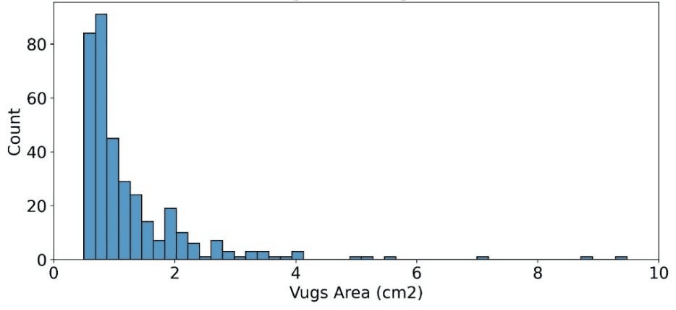Case studies
Precise Vug Detection for Elevating Reservoir Assessment
Get novel insights with our automated Vugs Detection Model
Get a quote
Summary
We refined the identification and characterization of vugs with cutting-edge analytical techniques, using Formation Micro Imager (FMI) logs by developing an automated Vug Detection Model utilizing advanced computer vision techniques. We present a six-step methodology that enhances precision adaptability, integrating intelligent algorithms for deeper insights into vug properties within subsurface geological formations.
Duration
6 Months
Team Size
3
01
Challenges
In collaboration with CC Energy Development (CCED) in Muscat, Oman, our client sought to address a significant challenge in identifying vugs from Formation Micro Imager (FMI) logs. These geological features play a pivotal role in reservoir evaluation, especially in carbonate rocks, but traditional methods, whether manual or semi-automated, presented limitations. The challenges stemmed from biases in manual picking, labor-intensive processes, and the inflexibility of parameter fine-tuning. Recognizing these obstacles, our team embarked on developing an innovative solution to revolutionize the Vug identification process using advanced imaging and data interpretation techniques.
As we delved into this challenge, it became evident that the accuracy of reservoir evaluation relies heavily on several factors, including the precise identification of vugs. Any inaccuracies in this process could lead to misguided interpretations of subsurface geological formations. Such misinterpretations, in turn, would impact crucial decisions related to hydrocarbon pore space and overall reservoir dynamics and consequently cost millions of dollars in loss. The urgency to address these challenges stemmed from the direct implications they posed to the integrity of reservoir characterization and resource extraction strategies and, ultimately, the business goals of our client.
It was immediately clear that Incorporating advanced data analytics in reservoir evaluation and employing advanced imaging technologies would significantly improve the detection and analysis of vugs. Utilizing AI for predictive modeling of reservoir behaviors enables more accurate forecasting of hydrocarbon extraction potentials.
02
Innovation
Our innovative solution revolves around developing an advanced Vug Detection Model, employing advanced computer vision techniques. In collaboration with CC Energy Development (CCED), we aimed to streamline the identification and characterization of vugs from Formation Micro Imager (FMI) logs. This six-step methodology, initiated by top-k mode extraction and concluding with filtering, forms the foundation of our approach.
Our approach involves a six-step methodology, each step contributing to the precision and adaptability of our model, allowing it to identify vugs that manual picking methods and other semi-automated solutions might miss. This comprehensive approach enhances the efficiency and accuracy of the vug identification process. The methodology encompasses top-k mode extraction, adaptive thresholding, contour identification, aggregation, advanced filtering, and optional filtering. Implementations of these techniques ensure a robust model for vug identification, contributing to the overall success of the project.
 Figure 1: High-level pipeline for our proposed methodology
Figure 1: High-level pipeline for our proposed methodology
What sets our solution apart is its innovative and cost-effective nature compared to established approaches. Unlike traditional, manual, or semi-automated methods that are prone to biases and inflexible in parameter fine-tuning, our Vug Detection Model offers a more scalable solution. By automating the process, we eliminate labor-intensive tasks and enhance the overall accuracy of Vug identification, making it a cost-effective and efficient alternative.
While implementing the solution, we encountered challenges such as high False Positives that necessitated reiterations from the original proposal. Fine-tuning parameters to achieve optimal results and addressing specific geological variations were key challenges. Through iterations, we refined our model to enhance its adaptability, ensuring that it can accurately identify vugs in diverse geological settings.
03
Impact
Implementing our Vug Detection Model yielded impressive results, giving an MAE of just 1.2 cm2. The high-level pipeline showcased in Figure 1 demonstrates the efficacy of our approach, with mode subtraction and adaptive thresholding enhancing local image variation. The precision of our model is further emphasized by the detailed contour representations in Figure 2, revealing individual vugs and providing comprehensive metrics such as vug count, mean, and standard deviation of vug areas within each 10 cm zone. The distribution plot in Figure 3 enhances the holistic understanding of vug types, which is crucial for reservoir characterization.
 Figure 2: Enhanced understanding of reservoir by providing detailed vugs information extracted from the reservoir
Figure 2: Enhanced understanding of reservoir by providing detailed vugs information extracted from the reservoir
 Figure 3: Additional insights extracted from the reservoir that tell us more about the reservoir dynamic
Figure 3: Additional insights extracted from the reservoir that tell us more about the reservoir dynamic
As we envision the future of our solution, key recommendations for enhancements lie in exploring semi-automated AI solutions to elevate model performance. Integrating advanced semi-automated techniques can refine the precision of vug identification, offering an even more accurate portrayal of subsurface geological features. Additionally, our focus on optimizing efficiency includes efforts to reduce the runtime of the model further, ensuring quicker and more streamlined analyses. Furthermore, addressing the challenge of False Positives remains a priority; future iterations will aim to implement strategies that further decrease the occurrence of false positives, enhancing the overall reliability of the vug detection process. These insights pave the way for a continually evolving solution, poised to set new standards in reservoir evaluation.
We invite collaboration and engagement from industry experts to contribute to our ongoing innovation journey. For more information or to share your perspectives on advancing the capabilities of our AI solution, feel free to contact us.
Impact metrics
Our impact in the vertical
Quantifying our success to showcase how we bring transformative AI solutions to healthcare
10X
increase in interpretation efficiency
>80%
accuracy in identifying vugs
<3 Sec
for each meter interpretation
case studies
Data Assessment Success Stories
How Our Swift Path Methodology Drives Real-World Impact
